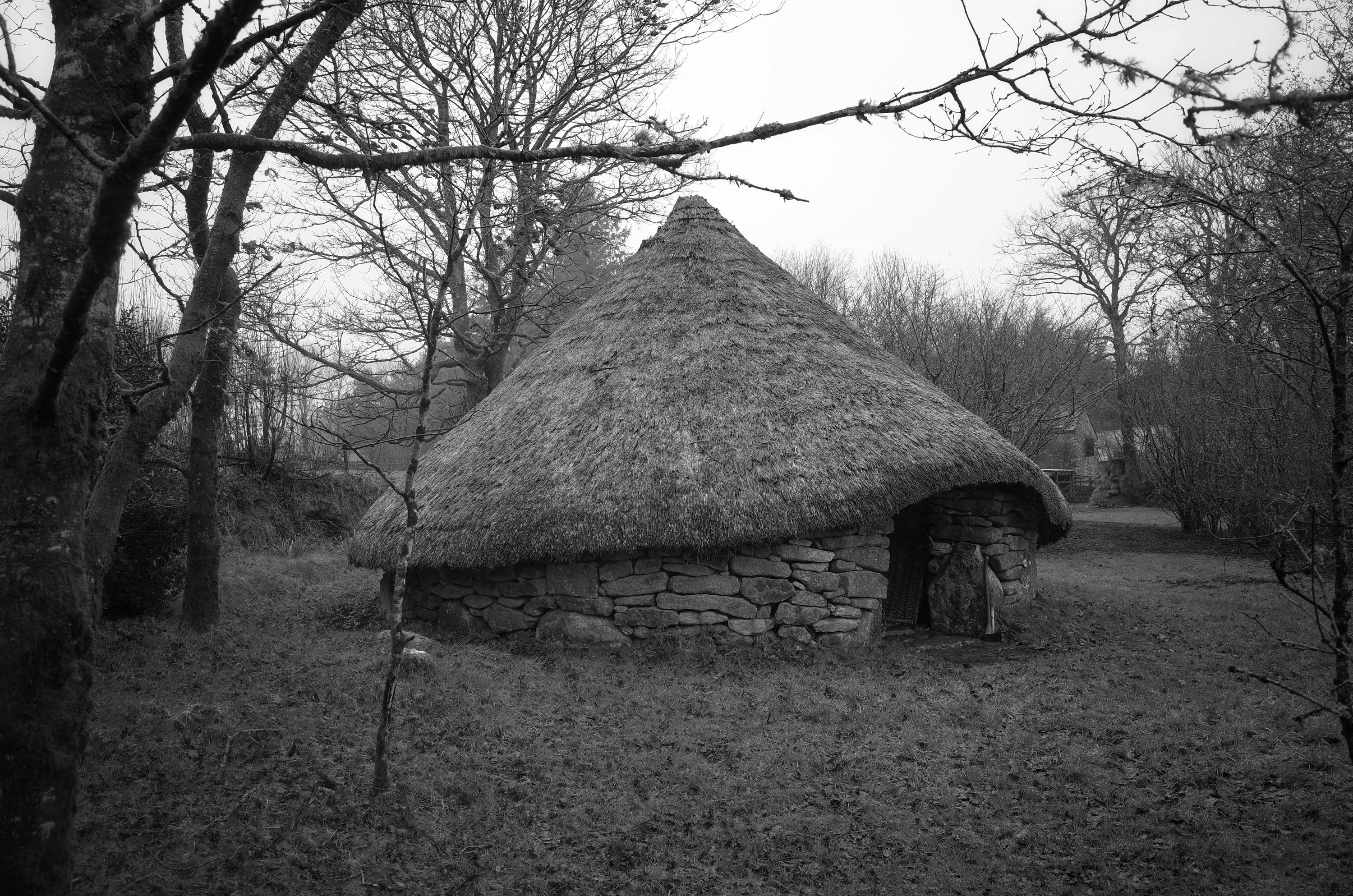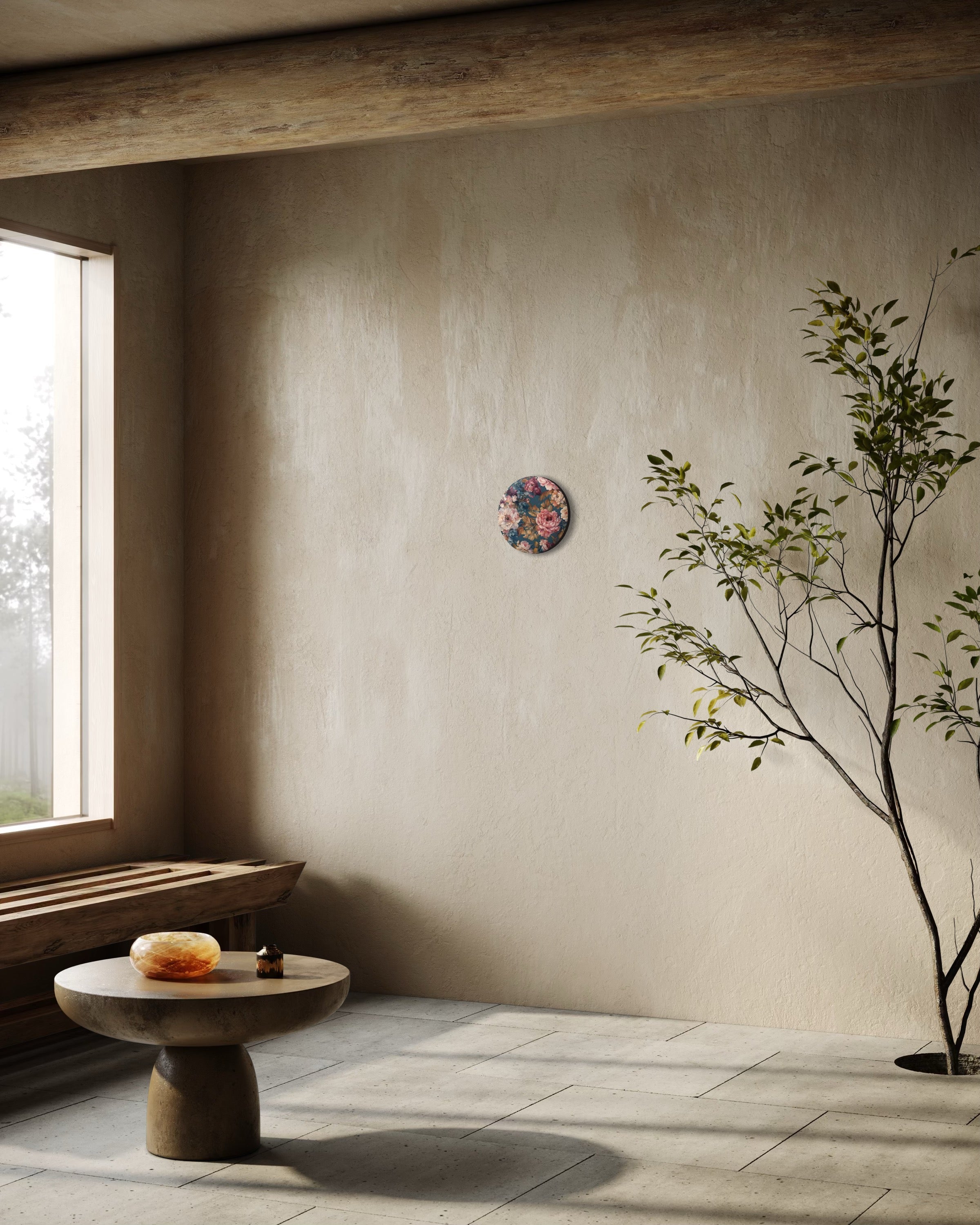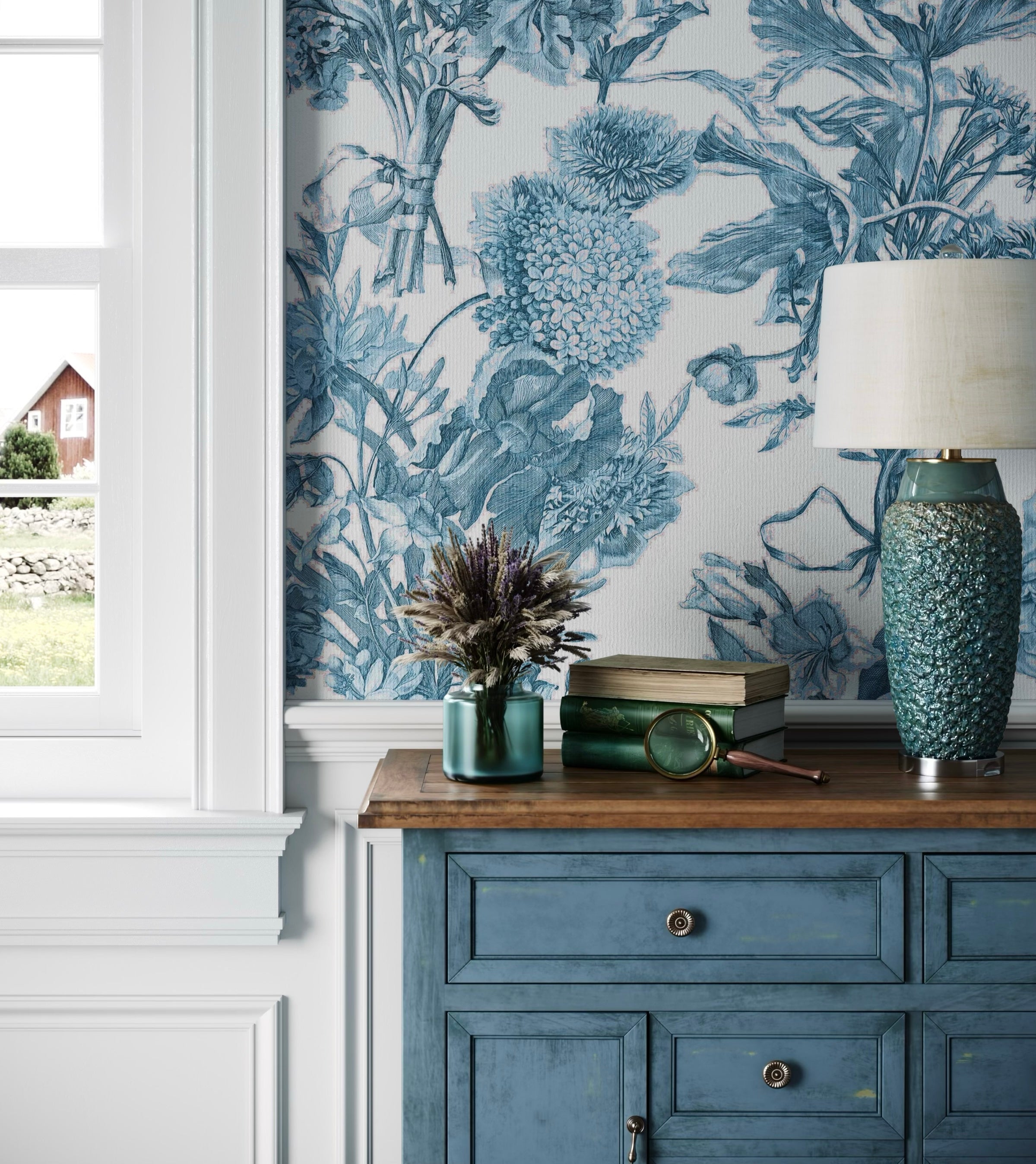
The Language of Thatch: When Roofs Were Woven from the Land
Rain arrives across the Devon moor with the sound of silk tearing, that distinct hiss audible moments before the first drops strike. She stands in the cottage garden, secateurs in hand, watching the thatch darken as water meets dried reed. The sound changes as rain intensifies: from whisper to rustle to something deeper, thousands of hollow stems receiving and channelling water downward, outward, away from the dwelling beneath.
No two rainstorms sound identical on thatch.
Inside, the sound becomes something else entirely. Not the sharp percussion of rain on slate or the hollow drumming on corrugated metal, but softer, more diffused. The thatch absorbs some sound whilst transmitting the rest in muted form, creating acoustic environment somewhere between outside and inside. The smell rises too, that particular scent of wetted straw, slightly sweet, faintly grassy, mixed with wood smoke from the hearth.
Thatch is living material in ways that tile, slate, and metal can never be. It grows. It's harvested. It dies slowly across decades whilst providing shelter, and eventually returns to earth. It harbours life throughout its service: insects, birds, mice, lichens, mosses. It breathes, allowing moisture to escape upward whilst shedding rain outward. It insulates through trapped air within and between stems, keeping homes warm in winter, cool in summer.
This is shelter woven directly from landscape.
Thatching as Technology: Reed, Straw, and Heather
Three primary materials built roofs across millennia.
Water reed (Phragmites australis) grows in wetlands, marshes, and along waterways. The stems, when properly harvested and dried, create the most durable thatching material. Their natural structure (hollow internodes separated by solid nodes, silica-rich outer surface) sheds water efficiently whilst resisting decay. A well-laid water reed roof can last 60 years. Sometimes 80. Sometimes longer, outliving the timber frame beneath.
The longevity made it valuable despite harvest challenges. Accessing wetlands. Timing cuts precisely. Drying thoroughly before use.
Wheat or rye straw served as more accessible thatching material in grain-growing regions. Agricultural byproduct, readily available. Straw thatch typically lasts 25 to 35 years. Less durable than reed but costing less initially. The stems, being softer and less water-resistant, required steeper roof pitches to shed water effectively. Traditional long-straw varieties (grown before modern short-stemmed wheat breeding) provided best thatching material.
Heather (Calluna vulgaris) dominated across Scottish and northern uplands where neither reed nor adequate straw grew. Heather stems, shorter and more irregular, were typically laid in turf-like sections. Thick, insulating layers that performed well in extreme highland conditions. Less water-resistant than reed but offering excellent wind resistance. Crucial properties in environments where winter storms and cold threatened more than rain.
The choice of material dictated everything else. Roof pitch. Laying technique. Fixing methods. Maintenance requirements. A reed thatcher's skills didn't directly transfer to straw work.
Underlayers beneath visible thatch varied regionally but typically included turf, brushwood, or coarse vegetation. These hidden layers, rarely visible once roof was complete, represented significant portion of a thatch roof's mass. They contributed substantially to thermal and acoustic properties.
The annual cycle of thatching work followed material availability and weather patterns. Reed cutting happened in winter, after frost had hardened stems. Straw became available after harvest, typically late summer through autumn. Heather cutting occurred in late summer, after flowering but before autumn rains.
 [Water reed (Phragmites australis) grows in marshlands, its hollow stems creating natural structure that sheds water whilst resisting decay for decades]
[Water reed (Phragmites australis) grows in marshlands, its hollow stems creating natural structure that sheds water whilst resisting decay for decades]
Cornish and Devon Thatch: Atlantic Weather Resistance
Steep pitches and wheat reed answered the challenge of horizontal rain driven by ocean gales.
Cornwall and Devon's thatching traditions developed under fierce Atlantic storms that could drive rain horizontally. Salt-laden air that corroded and weakened materials. High humidity that promoted rot. Wind strong enough to rip poorly secured roofing away entirely.
The regional response was wheat reed thatch laid at exceptionally steep pitches. Sometimes approaching 60 degrees. Allowing rain to shed immediately regardless of wind direction.
The steepness created distinctive silhouettes. Cornish thatched cottages squat low with roofs seeming almost vertical, overwhelming the modest walls beneath. This proportion wasn't aesthetic choice. Steep pitch prevented water penetration during driving rain whilst reducing wind resistance by allowing gales to flow over rather than catch under eaves.
Fixing techniques in southwest England emphasized security against wind. Thatchers used split hazel spars driven through thatch into underlying battens. Additional liggers (horizontal wooden rods) weighted with stone or iron held ridge sections against Atlantic gales. Some coastal cottages employed rope netting over entire roofs, anchored with stones. Appearance mattered less than survival when hundred-mile-per-hour winds arrived off the ocean.
Wheat reed for southwestern thatching typically came from specific heritage varieties grown locally into the twentieth century. These wheats produced long, straight stems with thick walls. Modern short-stemmed varieties, bred for mechanical harvesting, produce straw unsuitable for thatching. Supply problems emerged as traditional varieties disappeared from cultivation.
Contemporary thatchers in Cornwall and Devon now import Norfolk water reed or source wheat specifically grown for thatching. Disrupting the historical relationship between local agriculture and local roofing.
The National Trust maintains numerous thatched properties across Cornwall and Devon. Their conservation work has recorded regional variations in ridge finishing, eave treatment, and decorative elements that distinguished individual parishes. This documentation becomes increasingly valuable as the number of working thatchers declines.
Norfolk Reed and East Anglian Craft
Britain's premium thatching material, harvested from wetlands that fed medieval trade.
The Norfolk Broads, that network of rivers and shallow lakes in East Anglia, produces water reed considered Britain's finest thatching material. The specific environmental conditions create reeds with exceptional durability. Brackish water. Tidal influence. Mineral-rich soil.
Properly harvested Norfolk reed produces stems with thick walls, high silica content, and straight growth. A Norfolk reed roof can remain serviceable for 60 years or more before requiring replacement. Double or triple the lifespan of straw thatch.
Reed harvesting in Norfolk became specialised trade. Reed cutters worked in winter, when ice sometimes supported their weight and frozen stems cut cleanly. The work was brutal: standing in freezing water for hours, cutting by hand (later by adapted mowing equipment), bundling wet reed into 'bolts' weighing approximately 26 kilograms. A skilled cutter might harvest a tonne of reed per day under good conditions. Poor conditions could reduce output to a fraction of that.
The trade structure surrounding Norfolk reed developed unique characteristics. Reed merchants bought from cutters, graded and stored reeds, supplied thatchers across Britain. Quality grading was rigorous. Thatchers could identify reed origin by appearance, working qualities, and durability expectations.
East Anglian thatching technique differed from southwestern approaches. The relatively gentler climate allowed slightly less steep pitches. The superior material permitted refinements in finishing. Norfolk thatchers developed elaborate ridge decorations (patterns cut into final courses, decorative flourishes shaped from spars and liggers) that became regional signatures. Purely ornamental. Demonstrated craft mastery whilst creating visual distinction in landscapes where nearly every building bore thatched roof.
Regional pride attached to these decorative traditions. Villages developed signature patterns. Individual thatchers became known for particular techniques. The ornamentation served no functional purpose beyond aesthetic pleasure and craft demonstration, but that was sufficient justification. Beauty for its own sake. Skill displayed openly.
Contemporary Norfolk reed faces harvest pressures. The Norfolk Broads, designated wetland of international importance, balance conservation priorities with commercial reed cutting. Managing water levels. Controlling invasive species. Maintaining reed bed health whilst permitting sustainable harvest requires careful coordination between conservation bodies, reed merchants, and local authorities.
Climate change affects reed quality. Warmer winters reduce stem hardness. Changed rainfall patterns alter growth characteristics. These subtle shifts create concerns among thatchers who depend on material consistency.
Irish Vernacular: Rope Thatching and Peat Smoke
Weighted thatch answered Atlantic Ireland's fierce winds with techniques shared across Gaelic-speaking coasts.
Irish thatching developed under conditions similar to Cornwall yet produced distinctly different solutions. The western Atlantic seaboard (Connemara, Clare, Kerry, Donegal) faced prevailing winds that could exceed hundred miles per hour during winter storms. Securing thatch against such forces required innovation.
Rope thatching became characteristic Irish approach. After laying thatch bundles, thatchers secured them with rope networks weighted with stones. The ropes, typically made from twisted straw or later manila hemp, crossed roof surface in diamond or square patterns. Stones hung from rope ends, their weight holding entire system against wind uplift.
The visual effect was striking. From distance, an Irish cottage appeared to wear rope harness over its thatch, the dangling stones creating distinctive silhouette. Functional necessity became regional signature.
Regional variations existed within rope thatching tradition. Connemara thatchers favoured closer rope spacing with smaller stones. Clare thatchers used wider spacing with larger stones. These variations reflected local wind patterns, available stone types, and accumulated wisdom about optimal weight distribution.
The interior environment of Irish thatched cottages developed particular characteristics due to peat fuel use. Peat smoke, rising from central hearth, permeated thatch before escaping through roof. The smoke had preservative effect, killing insects, inhibiting fungal growth, extending thatch lifespan. The trade-off was interior smoke levels that seem intolerable by contemporary standards but were accepted reality of pre-industrial dwelling.
Hence 'blackhouse.'
Scottish Highland and Irish cottage interiors darkened from peat smoke accumulation, giving rise to term distinguishing them from later 'white houses' built with chimneys and lime-washed interiors. The blackhouse wasn't primitive dwelling but specifically adapted to available materials and fuel sources. Peat burns cooler than wood or coal, producing more smoke. Without adequate chimney draft, the smoke found its way through living space and thatch. The system worked, after fashion, though modern building regulations wouldn't permit it.
Irish Land Commission photographs from late nineteenth and early twentieth centuries document rope thatching extensively. These images, held in National Library of Ireland, show regional variations and construction details no longer readily visible in landscape. Most Irish thatched cottages have disappeared or been modernised, making photographic record increasingly valuable.
Contemporary Irish thatching survives primarily in conservation contexts. Folk parks like Bunratty in Clare and Ulster American Folk Park in Tyrone maintain thatched structures using traditional techniques. These living history sites preserve craft knowledge whilst acknowledging that rope thatching has largely passed from practical use to cultural memory.
Scottish Highland Blackhouses: Heather and Double Walls
Living roofs where smoke escaped through thatch and walls sheltered livestock.
Highland Scotland's harsh climate (long winters, strong winds, limited timber, abundant stone and heather) produced distinctive dwelling form called taigh-dubh (blackhouse). These structures, common into twentieth century across Western Isles, represented highly adapted response to environmental constraints.
Blackhouse construction used double wall technique. Inner and outer stone walls, typically unmortared, created cavity filled with earth, turf, or peat. This cavity provided insulation crucial for survival in climates where winter temperatures regularly dropped below freezing and gales could persist for days.
The thatch, usually heather but sometimes combining heather with bent grass or rushes, sat directly on stone walls without separate roof structure. No rafters or purlins. The thatch rested on walls, weighted down with stones or rope networks. This created extremely low profile, reducing wind resistance. Highland blackhouses appear to hunker against landscape rather than rise from it.
The lack of chimney meant peat smoke permeated interior before escaping through thatch. This served multiple purposes beyond heating. The smoke preserved stored food hung from rafters. It killed thatch-dwelling insects. It created atmospheric environment we would find nearly uninhabitable but which provided warmth and preservation in harsh climate.
Byre integration was common. One end of structure housed family whilst the other housed cattle or sheep during winter. Body heat from animals contributed to interior warmth. Manure accumulated beneath animal area, later spread on poor highland soils to improve fertility. This integration of human and animal dwelling under single roof seems primitive to modern sensibility but represented rational use of scarce heating resources.
After perhaps twenty years, the heavily smoke-impregnated thatch would be stripped and spread on fields. Providing nitrogen-rich fertiliser whilst making way for fresh heather covering. The cycle connected roofing, heating, food preservation, and agriculture in integrated system that waste-averse contemporary sustainability advocates might admire.
The last inhabited blackhouses on Lewis surrendered to modernity in 1970s and 80s. No one lives this way now. The structures remain, some maintained by heritage bodies, most slowly collapsing back into landscape from which they were built. Walking among ruins on Lewis or Harris, one encounters stone gable ends standing alone, heather thatch long since disappeared, the openings where families sheltered now exposing only sky.
 (Highland thatching created low-profile structures that hunkered against landscape, roofs sitting directly on stone walls without separate timber frame)
(Highland thatching created low-profile structures that hunkered against landscape, roofs sitting directly on stone walls without separate timber frame)
Scandinavian Turf Roofs: Grass as Living Insulation
In Norway, Sweden, and Iceland, roofs became meadows where goats grazed and wildflowers bloomed.
Scandinavian turf roofing represents perhaps the most biophilic traditional roofing approach. Here, thatch evolved beyond dried vegetation covering into living grass layer that grew, required mowing, and occasionally harboured grazing livestock.
The construction method placed birch bark sheets over wooden roof boards, creating waterproof membrane. Atop the bark came layers of turf, grass-side up. The grass continued growing, roots binding turf together, creating green roof in most literal sense. Thickness varied but commonly reached 15 to 30 centimetres.
The grass grew.
This seemingly obvious fact had significant implications. The living roof required maintenance. Annual mowing, unless goats performed this service naturally. Occasional reseeding where growth failed. Management of drainage to prevent waterlogging that could rot underlying structure. The roof was garden, requiring garden's attention.
The insulation properties exceeded anything dried thatch could provide. The mass of soil and living vegetation moderated interior temperature dramatically. Keeping homes warmer in winter. Cooler in summer. The thermal mass absorbed and slowly released heat, smoothing daily temperature swings that could otherwise make poorly-insulated dwellings uncomfortable.
Norwegian torvtak (turf roof) tradition produced distinctive architectural profile. The thick turf layer required strong roof structure capable of supporting significant weight. Norwegian log construction, using large diameter timbers, provided necessary strength. The resulting buildings appear almost embedded in landscape, particularly in mountainous regions where turf roofs echo surrounding meadows.
Wildflowers commonly established in turf roofs. Birdsfoot trefoil. Selfheal. Wild thyme. Harebells. The roofs became vertical meadow fragments, providing habitat and visual pleasure. Contemporary Norwegian and Icelandic buildings sometimes revive turf roofing, though usually with modern waterproofing beneath and lighter growing medium above. The aesthetic remains whilst technical execution updates.
Swedish tradition varied slightly. torvtak in Sweden often incorporated more birch bark, creating more robust waterproofing layer. Swedish examples sometimes featured decorative ridge ornaments or gable decorations that Norwegian examples typically lacked. These regional variations reflected both environmental conditions and cultural aesthetics.
Icelandic turf buildings merit particular mention. On island with minimal timber and extreme weather, turf became primary building material for walls as well as roofs. Icelandic turf houses created almost entirely from locally available materials represent remarkable architectural achievement under severe resource constraints.
Contemporary Scandinavian interest in turf roofing extends beyond heritage conservation. Modern green roof movement recognises benefits similar to those traditional builders understood: insulation, stormwater management, habitat provision, aesthetic integration with landscape. The traditional practice informs contemporary sustainable architecture, demonstrating how vernacular solutions address concerns we imagine are recent discoveries.

Breton and Norman Continuity
French Atlantic coastal traditions shared Celtic and Viking heritage, producing distinctive thatching approaches.
Brittany's thatching traditions, whilst sharing characteristics with other Atlantic regions, developed distinctive elements reflecting the peninsula's complex cultural history. Breton language's Celtic roots, medieval ties to Normandy, and geographic position between Atlantic and continental influences created unique synthesis.
Breton thatchers traditionally used rye straw, harvested from specific heritage varieties grown specifically for roofing purposes. The rye, typically hand-cut to preserve stem length, produced darker thatch than wheat straw. Breton roofs consequently appeared more sombre than English wheat-thatched equivalents.
Norman thatching in Calvados, Manche, and Orne developed under different constraints than Brittany despite geographic proximity. Here, thatching guilds exercised stronger control, standardising techniques and maintaining quality through apprenticeship requirements. The guild system, more formalised than British equivalents, created documentation that survived, providing detailed technical specifications now valuable for conservation work.
The half-timbered architecture characteristic of Normandy created different relationship between thatch and structural frame than British thatching typically required. Norman thatch worked with exposed timber framing, the visual composition balancing dark timber against light thatch. Aesthetic considerations influenced technical decisions more overtly than in purely functional British traditions.
French thatching faced more severe decline than British equivalent. Post-revolutionary land reforms and industrialisation proceeded more rapidly in France. Insurance regulations proved particularly hostile to thatch. By mid-twentieth century, French thatching had nearly disappeared outside heritage contexts. Recent revival efforts, partly driven by environmental consciousness and partly by heritage tourism, have produced modest renaissance.
Contemporary French thatchers often train in Britain or Netherlands, where craft continuity never fully broke. This knowledge transfer flows opposite to medieval patterns when French thatching guilds were teaching across Channel. The reversal illustrates how traditional craft knowledge survives through whatever pathways remain open, regardless of historical precedent.
 (Continental Atlantic traditions shared Celtic heritage whilst developing distinctive regional characteristics in threshold treatment and ridge finishing)
(Continental Atlantic traditions shared Celtic heritage whilst developing distinctive regional characteristics in threshold treatment and ridge finishing)
Material Cycles: Harvest, Lifespan, Renewal
From cutting through service to decomposition, thatching materials traced annual and multi-decade rhythms.
Reed cutting required specific timing. Too early, and stems contained excess moisture, promoting rot. Too late, and spring growth damaged stem integrity. The window opened after first hard frost, closed before spring growth resumed. In Norfolk, this meant December through February. Cutters worked in brutal conditions, standing in freezing water for hours, hands numbed despite gloves, breath visible in winter air.
The cut reeds required drying. Bundled whilst still wet, they needed protection from rain whilst allowing air circulation. Traditional reed yards featured thatched storage sheds with open sides, permitting air movement. Rushing this process guaranteed premature rot. Patience during drying phase determined roof longevity decades later.
Straw harvest followed grain harvest. The wheat or rye, cut by hand into the early twentieth century, was threshed carefully to avoid damaging stems. Mechanical threshing often broke straw, rendering it useless for thatching. Combine harvesting, universal in modern agriculture, destroys thatching potential entirely. Contemporary thatchers requiring wheat straw must source from heritage grain growers using hand harvesting or adapted equipment.
Heather cutting also demanded timing precision. Late summer, after flowering but before autumn rains. The moorland heather, cut in swathes using specialized hooks, was bundled and dried standing against temporary racks. Highland communities sometimes organised communal cutting days, multiple families gathering heather for winter thatching work.
The service lifespan varied dramatically by material and environment. Norfolk water reed, properly laid on appropriate pitch, could last 60 years. Exceptional examples exceeded 80 years. Wheat straw might achieve 30 years in sheltered locations but often required replacement after 25. Heather, whilst durable in its highland context, rarely exceeded 30 years.
Environmental exposure dramatically affected longevity. South-facing roofs, receiving more sun, dried more completely after rain but weathered faster. North-facing roofs stayed damper but suffered less UV degradation. Roofs shaded by trees accumulated moisture, promoting fungal decay, but avoided direct weather. Exposed coastal roofs faced salt spray and fierce wind but dried rapidly.
As thatch aged, it supported increasing biodiversity. Mosses established. Lichens colonised. Birds nested in eaves and ridges. Insects made homes in decaying material. By end of service life, a thatch roof represented complex ecosystem. Upon removal, the old thatch, now thoroughly composted, returned nitrogen and organic matter to soil. The cycle completing.
 (Harvested reed bundles await use, each stem cut at precise timing when frost has hardened structure but spring growth hasn't yet compromised integrity)
(Harvested reed bundles await use, each stem cut at precise timing when frost has hardened structure but spring growth hasn't yet compromised integrity)
Biophilic Living: Roofs That Breathe
Modern understanding reveals what traditional builders knew instinctively about permeable boundaries.
Contemporary biophilic design principles value natural materials, connection to living processes, and buildings that interact dynamically with environment rather than creating sealed barriers. Thatch embodies these principles completely.
The breathability of thatch creates moisture regulation impossible with impermeable roofing. Interior moisture from cooking, breathing, bathing passes through thatch rather than condensing on cold surfaces. This natural ventilation reduced dampness problems that plague poorly ventilated modern dwellings. The moisture passing through thatch evaporates into atmosphere, maintaining interior relative humidity within comfortable range.
Temperature regulation through thatch's mass and insulation properties creates stable interior environments. The material's low thermal conductivity reduces heat loss in winter, heat gain in summer. The thickness (typically 300mm to 450mm when new) provides thermal mass that moderates temperature swings. Buildings respond more slowly to external temperature changes, creating more comfortable interior conditions.
Acoustic properties receive less attention but matter significantly. Thatch absorbs sound rather than reflecting it. Rain sounds muted. External noise reduced. Interior acoustics softened. People living under thatch often remark on the quietness, how external sounds seem distant, how interior sounds don't echo harshly off hard surfaces.
The biodiversity harboured within and upon thatch creates dynamic living environment. Insects, whilst occasionally problematic, mostly provide food sources for birds. The birds, in turn, control insect populations whilst adding life and movement to dwelling surroundings. Mosses and lichens indicate air quality whilst contributing to thatch's ecosystem.
This permeable boundary between inside and outside, this hosting of life processes as integral part of building fabric, represents architectural approach nearly opposite to contemporary construction's emphasis on sealed, controlled environments. Modern buildings strive to exclude nature. Thatched buildings exist in conversation with it.
The environmental credentials of thatch surpass industrial roofing materials decisively. Renewable materials. Low embodied energy. Biodegradable end-of-life. Local sourcing reducing transportation impact. Traditional thatching represents genuinely sustainable building practice, not in aspirational future sense but in demonstrated historical fact.
Contemporary green building movements increasingly recognise that traditional practices often embody sustainability principles modern architecture laboriously discovers. The breathable buildings, natural materials, integration with local ecology that sustainable design pursues were default conditions in vernacular architecture. We spent century and half building sealed boxes dependent on mechanical systems, and now spend enormous effort trying to recover biological principles that thatched buildings demonstrated continuously.
 (Even deteriorating thatch demonstrates breathability and ecosystem hosting, moss and lichen colonising whilst structure slowly returns to earth)
(Even deteriorating thatch demonstrates breathability and ecosystem hosting, moss and lichen colonising whilst structure slowly returns to earth)
Contemporary Thatching: Craft Survival
Remaining practitioners face economic realities that threaten knowledge transmission.
Britain currently has approximately 250 to 300 professional thatchers. This represents dramatic decline from early twentieth century when probably ten times that number worked. The reduction reflects changed building practices, fire regulations favouring industrial materials, and economic pressures that make craft training difficult.
Training a thatcher requires years. The work demands physical strength, manual dexterity, spatial reasoning, and aesthetic judgment. Apprenticeship remains primary training method. The apprentice working alongside experienced thatcher, learning through observation and practice. This traditional model faces contemporary economic challenges. Minimum wage regulations make long apprenticeships at reduced pay problematic. Health and safety requirements add administrative burden. Insurance costs for employers taking apprentices create financial barriers.
The demographics of practicing thatchers skew older. Many master thatchers exceed 60 years. Retirement approaches for significant portion of current workforce. Without substantial influx of younger practitioners, knowledge transfer faces crisis. Some regional techniques exist only in handful of practitioners' memories. Once they retire or die, those techniques disappear.
Listed building regulations create guaranteed market for thatching services. Heritage buildings requiring thatch must use thatch. This regulatory protection sustains craft economically. But regulations also constrain. Requirements to match historical techniques may conflict with contemporary building codes. Fire safety regulations. Insulation requirements. Party wall considerations. Navigating these competing demands requires expertise beyond craft skill alone.
Cost comparisons between thatch and industrial roofing consistently favour industrial materials. Thatching a cottage might cost £35,000 to £55,000. Require several weeks work. Deliver roof lasting 25 to 60 years. Slate or tile might cost £18,000 to £28,000. Require days rather than weeks. Provide 80 to 100 year lifespan.
The arithmetic is unfavourable unless one values tradition, aesthetics, craftsmanship sufficiently to justify additional expense. Some people do. Not enough to sustain craft at historical scale.
Insurance for thatched buildings presents ongoing challenge. Fire risk, whilst manageable through proper specification and maintenance, creates insurer caution. Statistical data from periods when building standards were lower continues influencing premiums. Modern thatching, incorporating fire barriers and meeting contemporary specifications, performs far better than historical data suggests. Convincing insurance industry of this improvement remains ongoing challenge.
Heritage Crafts Association classifies thatching as endangered craft. Not critically endangered (that category reserved for crafts with fewer than 20 practitioners) but endangered nonetheless. The concern isn't immediate extinction but gradual decline that could reach critical threshold without intervention.
Training initiatives attempt addressing succession challenges. Heritage Crafts Red List. National Heritage Training Group programmes. Funding from Historic England supporting apprenticeships. These efforts slow decline rather than reverse it. Fundamental economic structures don't favour small-scale craft practice in contemporary economy.
The knowledge at risk extends beyond technique. Practising thatchers possess intimate understanding of material behaviour. They can assess reed quality by appearance and feel. They understand how different environments affect thatch performance. They know regional variations in technique, decorative traditions, historical practices. This embodied knowledge resists codification. It exists in practitioners' hands, eyes, and judgment.
Video documentation, technical manuals, and training programmes attempt capturing knowledge before it disappears. These efforts help. But watching someone thatch on video differs fundamentally from working beside them, feeling how material behaves, developing physical memory of correct motions. Some knowledge simply requires direct transmission through apprenticeship model.
Whether contemporary society values traditional craft sufficiently to support this transmission economically remains uncertain.
Conclusion: Shelter Woven from Landscape
The thatcher's billhook moves rhythmically, shaping reed ends flush with roof surface. Watching from the garden, one sees several things simultaneously. A roof taking shape. A craft performance, each movement economical. A material transformation, loose bundles becoming coherent architectural element.
And something deeper.
The act of covering shelter with materials cut from local landscape, shaped by hand, secured through techniques developed across centuries. Creates connection between dwelling and land that industrial materials cannot replicate.
Thatch demonstrates that sophisticated building performance requires neither industrial processing nor synthetic materials. The breathability, insulation, acoustic properties, moisture regulation. All emerge from simple materials arranged according to accumulated wisdom. The knowledge embedded in thatching practice represents collective experiment extending across millennia. Countless builders testing approaches, learning from failures, refining successes.
The question facing contemporary culture is whether traditional craft knowledge maintains value in world of industrial materials and digital design tools.
Economic arguments favour industrial approaches. Cheaper initial cost. Faster installation. Longer nominal lifespan. But these calculations omit factors difficult to quantify. The pleasure of living beneath material that breathes and evolves. The satisfaction of supporting craft continuity. The environmental benefit of using renewable, locally-sourced, biodegradable materials. The aesthetic integration with landscape and architectural heritage.
Some things resist being priced.
The cottage roof is nearly complete now. The thatcher working the ridge, the final and most exposed section. Each bundle positioned precisely, spars driven home, the pattern emerging from accumulated decisions. Tomorrow, when rain returns, the roof will perform as thousands of roofs before it have performed. Shedding water. Moderating temperature. Creating acoustic environment. Harbouring life.
Being, in the fullest sense, a living roof.
What we choose to cover our dwellings with matters. Not merely functionally but culturally, environmentally, aesthetically. The decision whether to maintain craft traditions or abandon them for industrial convenience shapes landscape, sustains or severs connections to place, preserves or discards accumulated knowledge.
Your roof might not be thatch. Few contemporary roofs are. But the questions thatch raises about material choices, craft value, relationship to landscape apply regardless. What covers your shelter? Where did it come from? Who made it? What does it do beyond keeping rain out?
These aren't romantic questions. They're fundamental ones about how we want to live, what we value, what we maintain and what we let disappear.
The thatch waits. The rain will test it. The years will season it. And someday, decades hence, it will return to earth, having provided shelter whilst harbouring life, having demonstrated that roofs can be more than barriers between inside and outside.
They can be woven from the very landscape they protect us from.

About This Article
This exploration of thatching traditions was researched and written for Sisuverse Journal | Nest & Nurtured as part of our ongoing investigation into how material practices shape domestic environments and connect dwellings to landscape. All historical and technical claims have been verified through consultation with conservation organisations, practising thatchers, museum archives, and academic sources.
Further Reading
- Jacqueline Fearn, Thatch & Thatching (Shire Publications, 2005)
- Nicholas Hall, Thatching: A Handbook (Intermediate Technology Publications, 1988)
- English Heritage, Practical Building Conservation: Roofing (Ashgate, 2015)
- Historic Environment Scotland, Thatch: A Maintenance Guide (2007)
- William Cox, An Illustrated Guide to Traditional Irish Thatching (The Liffey Press, 2013)
Related Collections
Explore natural materials that share thatch's biophilic principles in our Sisu Loom Collection. Handwoven textiles using natural fibres, pieces that breathe and age gracefully, maintaining connection to landscape and craft traditions that shaped their making.
External References & Resources
For those interested in deeper exploration of thatching traditions and conservation:
Historic Environment Scotland - Technical guidance on traditional roofing and conservation practices National Trust - Conservation work on historic thatched properties across England, Wales, and Northern Ireland Heritage Crafts Association - Endangered crafts documentation and training support Museum of English Rural Life - Agricultural tools and thatching equipment collections National Museum of Ireland - Documentation of Irish vernacular architecture and thatching traditions
A Note on Sources
Thatching history presents particular documentation challenges. Much craft knowledge passed through demonstration and apprenticeship rather than written record. What survives comes from multiple sources: conservation organisations documenting techniques before they disappear, folklorists recording rural practices, architectural historians studying vernacular buildings, and practising thatchers sharing embodied knowledge.
We have prioritised sources with clear provenance: museum collections, conservation body publications, academic research, and direct consultation with working thatchers. Where regional practices vary or historical records conflict, we have noted this rather than presenting single authoritative version. Vernacular architecture varied significantly by locality; presenting it otherwise would falsify its essential nature.
Some techniques described here are no longer practised outside heritage contexts. Others continue in modified form, adapted to contemporary regulations and materials availability. Our purpose is documentation and exploration of how materials and landscape shaped shelter, not romanticisation of past practices or prescription for future building.
Photography Credits
All images via Unsplash:
- Black and white image of a thatched cottage: Thomas Roberston
- Water reed wetland detail: Ludovico Ceroseis
- Abandoned thatched structure: Razvan Trif
- Northern European thatched roof: Barnabas Davoti
- White-walled cottage with wooden balcony: Sebestian Dumitru
- Vertically stacked reed bundles: Christopher Smith
- Umbrella roof structure: Paulus Stauch
- Dormouse on thatch: Marcus Ganahl
Specific image attributions available upon request for editorial compliance.
Explore material culture investigations in Sisuverse Journal | Nest & Nurtured. How pattern, craft, and natural materials transform houses into sanctuaries.




